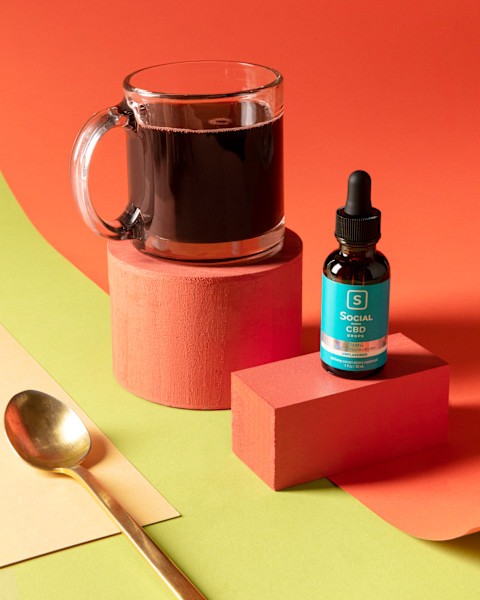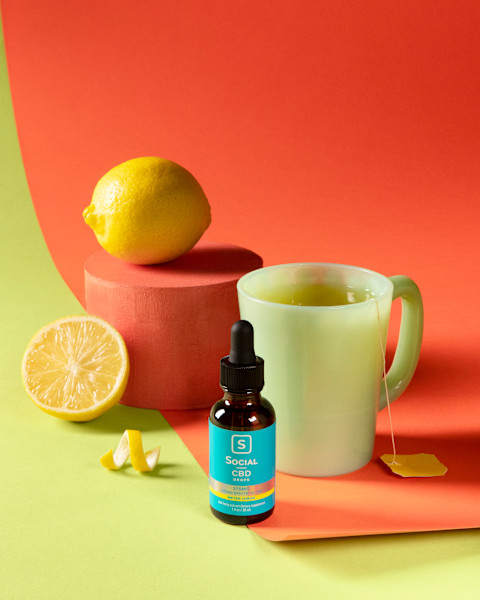4 Fascinating Things We Learned About Adding CBD To Coffee

Depending on where you live, you've probably seen the signs. CBD-infused lattes are the new soup of the day. After collagen peptides, MCT oil, and mushrooms made their way into our coffee, it was only a matter of time, really. But we have a lot of questions—mainly, how does that work, exactly?
Before we get to that, a quick refresher: CBD is short for cannabidiol, one of the many compounds found in the cannabis plant. This compound, a cannabinoid, has been on the rise (and in more foods and skin care products than we can count now) for the past couple of years thanks to a host of factors, from the 2018 Farm Bill, which federally legalized it, to an overwhelming amount of anecdotal evidence touting its body-balancing effects. (Oh, and unlike THC, the other famous cannabinoid, CBD isn't psychoactive.)
Why people love adding CBD to their coffee.

Anecdotally, there are a number of reasons people drink CBD-infused coffee: Some say that the effects of CBD can counter the jitters or that "wired" feeling of drinking too much coffee. Others believe that small amounts of CBD can be stimulating, so adding a dropper's worth to coffee may enhance focus.
The truth is, everyone processes CBD differently (because everyone's endocannabinoid system—the group of neurotransmitters that interprets how cannabinoids affect you—is unique), and the research we have about how it affects our bodies is still pretty limited at this point. We do know a few things about how CBD works, so we turned to Jessica Knox, M.D., MPH, co-founder of the American Cannabinoid Clinics and a preventive medicine physician who's spent time researching the endocannabinoid system, to help us understand what might happen when we mix CBD and caffeine. Here's what we learned:
1. Double the benefits?
Adding CBD to coffee is almost like a two-birds-one-stone situation: "While there's nothing wrong with doing it," Knox says of the trend, "you're not getting any additional benefit from either the CBD or the caffeine by consuming them together compared to consuming them separately. But if with your coffee is how you like to take your CBD, by all means—take them together!"
As a side note, one of the speediest ways to absorb CBD oil is by taking it sublingually (holding it underneath the tongue for about 30 seconds).
2. CBD and caffeine won't counteract each other.
Most people want to know if adding CBD to coffee just counteracts the effects of caffeine—as in, what's the point, and do opposing effects matter?
"To my knowledge, CBD and caffeine do not interact," says Knox. The science can go pretty deep here, but Knox explains it from an overarching standpoint: Caffeine makes us feel alert by preventing adenosine—the neurotransmitter responsible for making us feel tired—from binding to receptors in our brain and cuing sleepiness. "Meanwhile, CBD reduces the reuptake of adenosine1, keeping more adenosine in circulation in the brain." According to Knox, these two effects, though related, are neither synergistic nor antagonistic to one another. "So presumably, you can take caffeine and CBD together and still derive the respective benefits of both."
3. Start low and slow.
Figuring out how much CBD oil to drop into your cup of coffee or tea is all about knowing what dose works for you. "There is no single optimal CBD dose that applies to everyone because we all have different levels of endocannabinoid tone," says Knox.
For a general guideline, she says that most clinicians recommend starting with a low dose—about 5 mg of CBD—then slowly increasing the dose if and as needed. "The dose that works for your family member or your friend will likely be different from the dose that works for you, and a gradual titration of CBD allows you to find the dose that is best for you. Ultimately, 20 to 50 mg of total daily CBD seems to be a good wellness dose for most of us."
Besides choosing a high-quality CBD oil, of course, you can play around with flavors. Social CBD, for example, whose CBD products are lab-tested and certified to be clear of heavy metals, pesticides, and unwanted microbials, makes broad-spectrum hemp-derived CBD drops that are rich in 60 cannabinoids (with 0.0% THC) in flavors like Vanilla Mint, which is tasty in a cup of joe, and Meyer Lemon and Pomegranate Tea, which are perfect for tea drinkers.
And just a word on heat: Some studies have found that CBD degrades when exposed to heat, potentially losing some of its potency. Try adding CBD to an iced coffee or tea, or just let a piping hot mug cool down for a few minutes before adding your CBD.
4. Give it time.

Especially if you're starting out with a low dose, Knox points out that "generally healthy people may not 'feel' any particular difference, though they'll still be getting the general benefits of CBD. Think of it as adding a vitamin supplement to your routine or starting a new skin care regimen—noticeable results likely won't show up overnight.
However, some people may notice after a couple of weeks that they're generally less stressed, more friendly, and so on. (And if you're trying to address a particular condition or concern with CBD, or if you're taking prescription drugs, have a conversation with your doctor or a clinician familiar with the endocannabinoid system to help you find an optimal dosing plan.)
Jessica Knox, M.D., is not affiliated with Social CBD.
